
Ripley is a town in the Amber Valley borough of Derbyshire, England. Ripley engineers came up with some early improvements to the railway system.
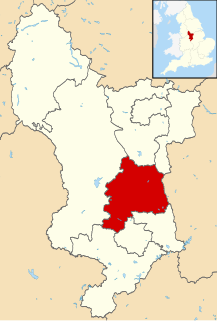
Amber Valley is a local government district and borough in the east of Derbyshire, England. It takes its name from the River Amber. It covers a semi-rural zone with four main towns whose economy was based on coal mining and remains to some extent influenced by engineering, distribution and manufacturing, holding for instance the headquarters and production site of Thorntons confectionery.

Heanor (/ˈhiːnə/) is a town in the Amber Valley district of Derbyshire in the East Midlands of England. It lies 8 miles (13 km) north-east of Derby and forms, with the adjacent village of Loscoe, the civil parish and town council-administered area of Heanor and Loscoe, which had a population of 17,251 in the 2011 census.

Eastwood is a former coal mining town in the Broxtowe district of Nottinghamshire, England, 8 miles (13 km) northwest of Nottingham and 10 miles (16 km) northeast of Derby on the border between Nottinghamshire and Derbyshire. Mentioned in Domesday Book, it expanded rapidly during the Industrial Revolution. The Midland Railway was formed here and it is the birthplace of D. H. Lawrence. The distinctive dialect of East Midlands English is extensively spoken, in which the name of the town is pronounced.
A mining accident is an accident that occurs during the process of mining minerals or metals. Thousands of miners die from mining accidents each year, especially from underground coal mining, although accidents also occur in hard rock mining. Coal mining is considered much more hazardous than hard rock mining due to flat-lying rock strata, generally incompetent rock, the presence of methane gas, and coal dust. Most of the deaths these days occur in developing countries, and rural parts of developed countries where safety measures are not practiced as fully.
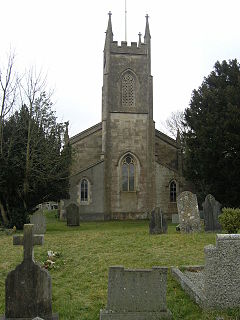
Coleford is a village and civil parish in Somerset, England, situated on the Mells River in the Mendip Hills five miles west of Frome. The parish has a population of 2,313 in 2011.

Fishburn is a village and civil parish in County Durham, in England. It is situated about 12 miles west of Hartlepool. It had a population of 2,454, increasing to 2,588 at the 2011 Census.
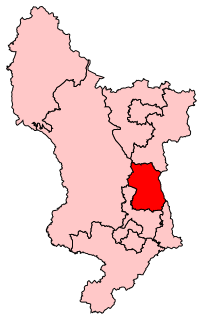
Amber Valley is a constituency in Derbyshire, represented in the House of Commons of the UK Parliament since 2010 by Nigel Mills, a Conservative.

Landfill gas is a mix of different gases created by the action of microorganisms within a landfill as they decompose organic waste, including for example, food waste and paper waste. Landfill gas is approximately forty to sixty percent methane, with the remainder being mostly carbon dioxide. Trace amounts of other volatile organic compounds (VOCs) comprise the remainder (<1%). These trace gases include a large array of species, mainly simple hydrocarbons.

Ironville in Derbyshire, England, was built about 1830 by the Butterley Company as a "model village" to house its workers. The population of the civil parish was 1,851 at the 2011 Census. It is situated between Riddings and Codnor Park.
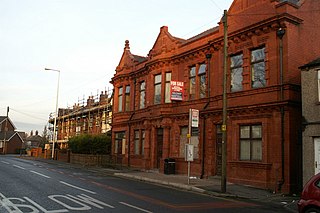
Abram is a village and electoral ward in the Metropolitan Borough of Wigan, Greater Manchester, England. It lies on flat land on the northeast bank of the Leeds and Liverpool Canal, 2 miles (3.2 km) west of Leigh, 3 miles (4.8 km) southeast of Wigan, and 14.5 miles (23 km) west of Manchester. Abram is a dormitory village with a population of 9,855.
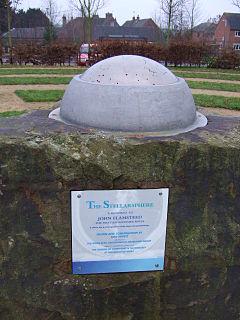
Denby is a village in the English county of Derbyshire that is notable as the birthplace of John Flamsteed, England's first Astronomer Royal, and the location of the Denby Pottery Company. The population at the 2001 Census was 1,827, increasing to 2,190 at the 2011 Census.

Codnor is a Derbyshire village and civil parish in the Amber Valley district, and a former mining community, with a population of 3,766 as taken at the 2011 Census. It is approximately 12 miles from the city of Derby and 14 miles from Nottingham by road.

Pontnewydd is a suburb of Cwmbran in the county borough of Torfaen, south-east Wales.

Micklefield is a village and civil parish east of Leeds, West Yorkshire, England. It neighbours Garforth, Aberford and Brotherton and is close to the A1 Motorway. It is in the City of Leeds metropolitan borough. The population as of the 2011 Census was 1,893, increased from 1,852 in 2001.
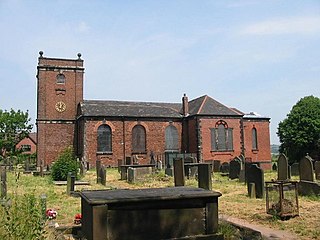
The ecclesiastical parish of Norton le Moors is located in the north-east of the city of Stoke-On-Trent, in the county of Staffordshire. The majority of the parish is in the city however some lies in the Staffordshire Moorlands district. Approximately 3.4 miles (5.5 km) north of Hanley, one of six major towns that joined together to form the city of Stoke-on-Trent in 1910. Norton le Moors borders Ball Green in the north, Stockton Brook in the east, Milton in the south, and Bradeley in the west, making it one of a number of small villages in the Stoke area.
Gas protection is the prevention or control of the penetration of hazardous gases into buildings or other types of real property. It usually involves either blocking entry pathways or removing the source of the gas.
















